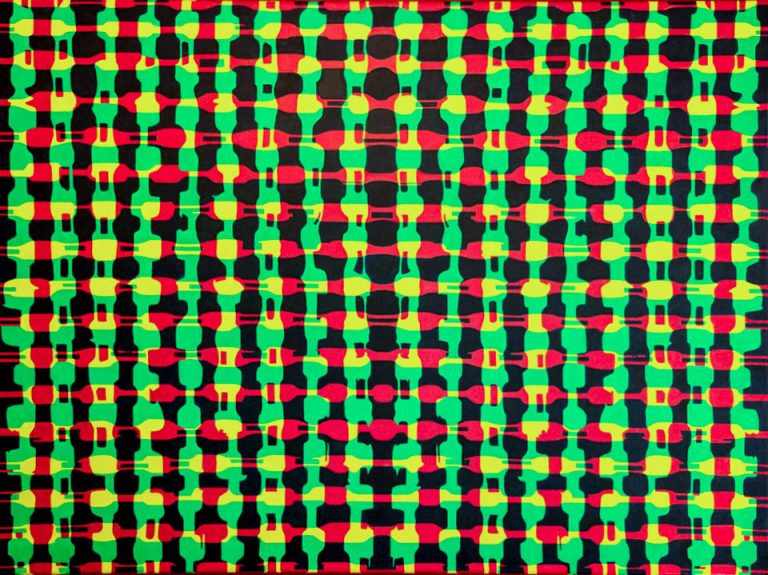Kraut Harmonia

Karlheinz Stockhausen advised his students to avoid any repetition while creating music. On the other hand, Hans Jaki Liebezeit the drummer of the famous German krautrock band Can (who were students and followers of Stockhausen) had completely opposite ideas about repetition in music believing that repetition is everything and that “without repetition there is no groove”.
In this painting (that in some ways is a picture of mentioned kind of music) I tried to put these two principles (repetition and non-repetition) together in a way that would bring up a harmonious result rather than an exclusion of each other. Combinations of the two are multiple: the parallel vertical and horizontal elements are repetitive, but they are not the same, and where they intersect each other there are new shapes in different colors popping out; the entire image is divided by the vertical axis leaving each side with multiple non-repetitive detail that become repetitive as they mirror the other side of the painting with the same pattern. However, all the shapes and colors on the left side although the same as the mirroring shapes and colors on the right side are not exact copies of each other for being painted by a human and not machine – they differ slightly. Also, the central vertical element is the only one that is not duplicated (non-repetitive) but when split in two by the vertical axis its left side has been repeated on the right side of the same element; further on, the entire painting is having two sides that are mirroring each other when divided vertically but not when divided by a horizontal axis. The horizontal elements are thinner and on the first sight look different than the vertical ones (red and green respectively) but if the vertical elements were made from rubber and stretched, they would be the same as the horizontal ones, etc.
Somebody may see them as a strange multi-tonal music scales.
The colors chosen have important roles here: the two opposite principles are represented with the two very opposite colors: green and red. Vertical greens run against red horizontals just to reconcile in the yellow (not brown, as expected) intersections creating a new flood of different shapes in different colors. The organic black (with a slight tone of the Prussian blue) background naturally recedes and brings forward the other colors. The black background also has a symbolic function here as the krautrock musicians – the first after WWII generation – were dealing with the dark legacy of the generations that came before them and were not ready yet to face it; the answer to the silence of their fathers was loud electronic music of the kids growing up after the War.
I did make some abstract pieces before (mostly digital) but in this painting it was for the first time that I went beyond the form and put some sound meaning into it. The abstract form was dictated by the subject as I cannot see the other form suitable for describing this kind of music. This was also in consistence with my conscious effort to avoid the traps of developing any style – this painting is very different from the one that preceded it and will be unlike the one that will follow.
Some viewers may find traces of op art here. If you do – go ahead and enjoy it, however, more important about this painting is its aesthetics; they are different from the aesthetics of a landscape or an abstract expressionist piece – it follows the aesthetics of the music that is often electronic, amorphous (kosmische musik) different than the music we usually listen to on the local radio station. With that precaution one might start exploring the details of the painting and if the viewer can see some kind of harmony in their interrelations that would be the sign that I have succeeded in my intention.
Probably the best description of my idea to put repetitive and non-repetitive principles in the same place can be find in the book about the krautrock band “Can” titled “All Gates Open: The Story of Can” as one of the coauthors and the member of the band Irmin Schmidt recalls him sitting in a moving train’s compartment listening to the repetitive sounds of the train and looking out the window where non-repetitive scenes occur one after another each moment.



Recent Comments